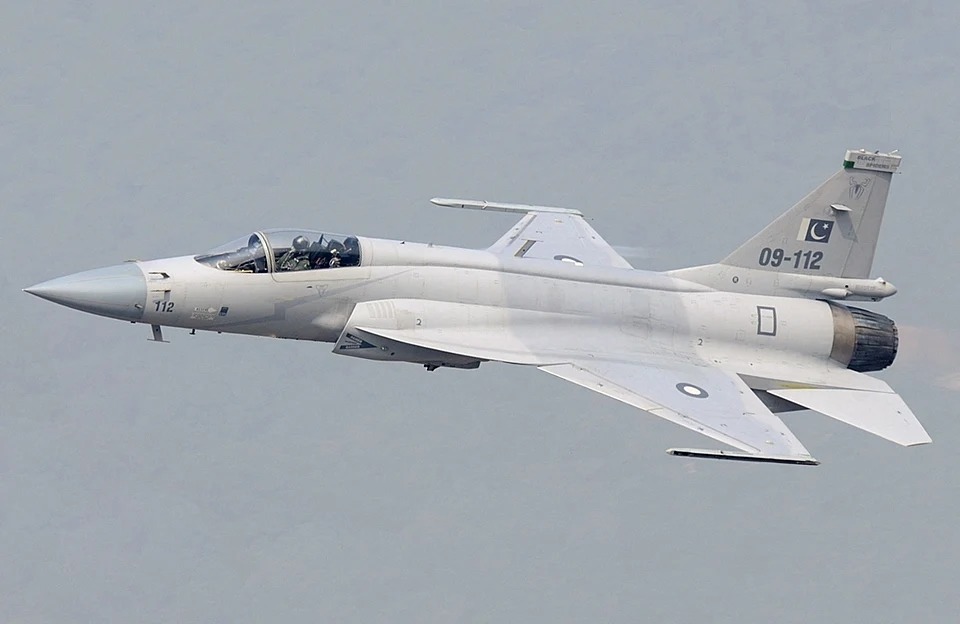Table of Contents
In a major heightening of inter-border hostilities, the Indian Air Force (IAF) downed several Pakistani JF-17 Thunder fighter aircraft that tried to intrude into Indian airspace after India’s retaliatory raids in Pakistan-occupied Kashmir (PoK). This is a pivotal moment in contemporary South Asian air warfare and raises serious doubts about the trustworthiness of Chinese-origin fighter technology employed by Pakistan.
This article analyzes the incident, the capabilities of the planes involved, the evidence that has been released thus far, and what this does for regional security.
India Downs Pakistan’s JF-17 Fighter Jets
The encounter took place soon after India carried out a string of preemptive raids on terror launchpads in PoK and within Pakistan under Operation Sindoor. In retaliation, Pakistan launched several JF-17 Block III fighter aircraft to establish airspace superiority along the LoC.
Retaliating, the IAF deployed Rafale fighter jets from Ambala air base and Su-30MKI fighter jets from a forward air base. Employing long-range Meteor and Astra missiles, Indian pilots effectively destroyed at least two JF-17 fighters, with radar evidence and drone images of wreckage in PoK establishing the kill.
What is the JF-17 Thunder Block III?
The JF-17 Thunder is a light, multi-role fighter co-developed by China‘s Chengdu Aircraft Corporation and Pakistan Aeronautical Complex (PAC). Its Block III variant is sold as a fourth-generation+ aircraft with capabilities such as:
-
KLJ-7A AESA radar
-
PL-15 Beyond-Visual-Range (BVR) missiles
-
Electronic warfare systems
-
Helmet-mounted sight systems (HMSS)
Despite these upgrades, recent combat performance raises concerns about its reliability and survivability against modern Western aircraft.
JF-17 Thunder: Not So Thunderous After All?
The JF-17 Thunder, developed jointly by China’s Chengdu Aircraft Corporation and Pakistan Aeronautical Complex, has been widely marketed as a cost-effective 4th-generation multirole fighter. The Block III variant, Pakistan’s latest upgrade, includes:
-
KLJ-7A Active Electronically Scanned Array (AESA) radar
-
PL-15 long-range BVR missiles
-
Helmet Mounted Display (HMD) system
-
Enhanced stealth and electronic warfare features
However, Indian defense experts argue that while impressive on paper, the JF-17 lacks real combat resilience when faced with next-gen fighters like the Rafale.
India’s Aerial Response: Precision, Power, and Proof
According to sources from the Indian Air Force:
-
Two JF-17s were downed by Meteor missiles launched from Indian Rafales over the Poonch sector.
-
Another was neutralized by a Su-30MKI using an Astra Mk-II BVR missile.
-
No Indian aircraft were damaged or lost.
-
Wreckage and heat signature data have been shared with allied partners as confirmation.
The IAF’s radar logs and surveillance drone footage show flaming debris landing on the Pakistani side of the LoC, consistent with the known shape and size of the JF-17 airframe.
Technical Comparison: JF-17 Block III vs Indian Rafale
Despite boasting Chinese support, the JF-17 lacks the integrated capabilities and combat testing experience of the French-built Dassault Rafale. Additionally, the PL-15 missile’s real-world effectiveness remains unverified, especially against Indian EW countermeasures.
| Specification | JF-17 Block III | Indian Rafale |
|---|---|---|
| Engine | Chinese WS-13 or RD-93 | Snecma M88-2 |
| Radar | KLJ-7A AESA | RBE2 AESA |
| BVR Missile | PL-15 (120–150 km) | Meteor (150–200 km) |
| EW Suite | Chinese Origin | SPECTRA (French) |
| Max Speed | Mach 1.6 | Mach 1.8+ |
| Combat Radius | ~1,200 km | ~3,700 km |
| Cost | ~$35 Million | ~$80 Million |
Performance of Pakistani JF-17s in Real Combat
JF-17 Block III: Key Specs
-
Developer: Pakistan Aeronautical Complex & Chengdu Aircraft Industry (China)
-
Radar: KLJ-7A AESA
-
Missiles: PL-15 (BVR), PL-10 (WVR)
-
Max Speed: Mach 1.6
-
Operational Range: ~1,200 km
-
Cost: $30–35 million per unit
Despite the technological upgrades in the Block III version, its avionics and radar jamming capabilities lag behind Western counterparts, making it vulnerable to advanced BVR missiles like the Meteor used by Indian Rafales.
Rafale Jets Dominate: How India Neutralized the Threat
The Dassault Rafale, inducted into the IAF in 2020, comes equipped with:
-
RBE2 AESA Radar
-
Meteor BVR Missile (150+ km range)
-
SPECTRA Electronic Warfare System
-
MICA IR/WVR Missiles
-
Superior Infrared Tracking and Targeting
During the engagement:
-
Rafale jets fired Meteor missiles, scoring confirmed hits on at least one JF-17.
-
Su-30MKIs, armed with Astra Mk-1 and Mk-2 BVR missiles, reportedly brought down the second JF-17 after a successful radar lock-on.
Geopolitical Fallout: Regional and Global Reactions
India:
The Indian Defense Ministry has praised the IAF’s professionalism and reiterated its zero-tolerance policy on terrorism. IAF Chief Air Chief Marshal V.R. Chaudhari emphasized the importance of technological superiority and precision warfare in maintaining air dominance.
Pakistan:
The Pakistan military initially claimed to have downed Indian jets but has since backtracked under scrutiny. No photographic or radar proof has been shared.
Global:
-
France expressed confidence in Rafale’s performance, dismissing Pakistan’s claims.
-
United States and UK urged restraint but recognized India’s right to self-defense.
-
China, Pakistan’s defense partner, has not commented publicly, though the JF-17’s underperformance raises concerns about China’s growing defense exports.
Analysis: JF-17 vs Rafale – A Comparative Look
To fully understand the outcome of this aerial clash, it is essential to compare the capabilities of the JF-17 Thunder and the Rafale.
| Feature | JF-17 Thunder | Dassault Rafale |
|---|---|---|
| Radar | KLJ-7A AESA | RBE2 AESA |
| Missiles | PL-15, C-802 | Meteor, MICA, ASMP |
| Speed | Mach 1.6 | Mach 1.8+ |
| Combat Range | 1,200 km | 3,700 km |
| Weapon Payload | 3,700 kg | 9,500 kg |
| Cost | $35 million per unit | $80 million per unit |
The Rafale outclasses the JF-17 in almost every category: range, weapons load, and radar systems. The JF-17, while cost-effective, cannot match the combat performance of more advanced Western fighters like the Rafale or F-16.
Conclusion
For Pakistan, this encounter may result in a reconsideration of its military strategies and perhaps a change in its defense buying priorities. Meanwhile, international powers are keeping a close watch on events, with many urging the use of diplomacy to avoid further escalation in the already tense region.


 Protection of the Aravalli Range: Import...
Protection of the Aravalli Range: Import...
 Viksit Bharat Shiksha Adhishthan Bill 20...
Viksit Bharat Shiksha Adhishthan Bill 20...
 Jumping Genes: The Revolutionary Discove...
Jumping Genes: The Revolutionary Discove...

























